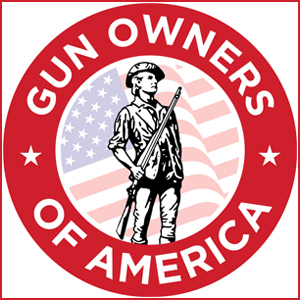Testing Single Action Army clones, replicas and look-alikes against Colt's original.
The Colt Single Action Army is arguably the most culturally significant firearm in the American story. The gun was, surprisingly, not made in what we could call significant numbers. It’s estimated that Colt’s production of the gun stands today at about a half-million (for reference, Glock has passed 20 million), certainly not a number that should allow it such deep meaning in the great American story considering just how many competitions it had in its time.
Even today, it has competition in the form of clones and copies, arguably more of those have been made than by the Colt company. Since real Colts are often not shot or are considered collector’s items, it’s prudent to examine two new guns and see how they stack up to the competition—and older SAAs from Colt itself.
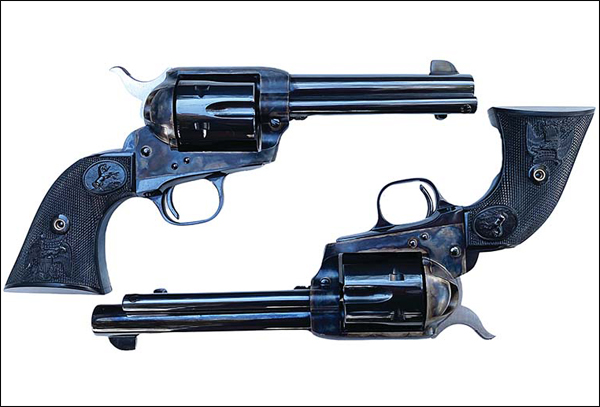
Does A Colt Shoot Better Than The Rest?
I’ll cut right to the chase when it comes to my personal experience with the SAA. I’ve shot no small number of Single Action Army clones and replicas. The bulk are very fine guns in their own right, some are exceptional shooters and others are exceptional just lying there not being fired. I’ve yet to find a single replica out there that, in terms of materials and accuracy, is the equal of a real Colt SAA.
In my direct experience—thousands of rounds and ranges exceeding 200 yards—have shown me that Colt SAAs are, on average, substantially more accurate than any replica. My average accuracy loads for the .45 Colt have changed a bit over the years, but I’ve recently been using Rim Rock Bullets for my cast loads. These bullets are exceptionally accurate, and I’ve taken a shine to the 255-grain SWC sized at .452 inch. This gets me just shy of 900 fps in a 5.5-inch Colt. My lifetime bench accuracy with Colts is about 2.5 inches at 25 meters, replicas are 4 to 5 inches across the board in group shooting. I never expect a replica to group well on paper as a result or shoot to point of aim, which is a large issue.

The Standard Manufacturing Single Action Revolver (top) versus the Colt. Both of these are 4¾-inch barrels in .45 Colt. They’re externally similar, but vary enough that they can’t be considered a 1:1 copy.
I load my ammo with seating and crimping as two separate operations—some people just use the seating die to crimp. When loading revolver rounds, I like the Lee Factory Crimp Die to manually set the case mouth into the crimp grooves on my bullets. Some people will strongly disagree with me on this, but in my time with cast bullets, I’ve found this uniforms the cartridge far better, and I’ve seen groups tighten.
Many people out there will slug their barrels to determine the best bullet diameter (I know some of my guns shoot much better with .454-inch bullets than they do .452 inch), but there’s a certain economy of scale where I prefer all my guns to shoot well with one or two loads than to have each gun shoot a bit better with a specific load. Again, this is personal preference and I’ve had some that’ll group tighter than a modern match pistol, but I’ll take a 2.5-inch average if I only have to keep one bullet in stock and plan accordingly.
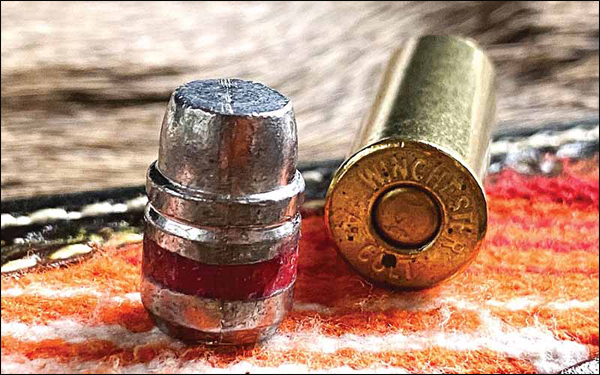
Rim Rock Bullets makes a wide variety of bullets suitable for single actions. This is the author’s new favorite, the 255-grain SWC. It isn’t a true Keith bullet, but it’s just as accurate and great for crossover use for range and field.
Point Of Aim Vs. Point Of Impact
This is the most important issue I’ve seen in my time with these guns. The SAA has no adjustable sights. Adjusting your point of impact is no easy feat, and it’s really best left to a gunsmith because you’re going to have to remove metal on the sight for elevation, or have a smith adjust your barrel in a vice to manually turn it to move windage.

Virtually all Colts I’ve shot shoot point of aim at 25 meters, and if they don’t, they are damn close. Most replicas aren’t so lucky. The only one I’ve had shoot point of aim at this distance was the Standard Manufacturing Single Action Revolver, though it wasn’t as accurate on paper by a noticeable margin. I’ve had three replicas from one manufacturer shoot to three different zip codes with the same ammo. With my Colts, I’ve been able to easily tailor loads to shoot to point of aim. Sometimes I have to sacrifice bullet weight or adjust speed, but I’ve never had a Colt that I’ve failed to reliably hit an IDPA silhouette with at 300 yards.

Colt firing pins are slightly tapered and have a square face. You’ll see a great deal of variance in the hammers on import guns; many have a small safety lever and some even have Ruger-style transfer bars.
I read Elmer Keith as a kid. I thought it was normal to try to hit plates at long range with a revolver after I spent my time reading Sixguns and Sixgun Cartridges and Loads. It’s the definition of fun: waiting for that steel to ring after what seems like an hour of flight time.
The thing that disappoints me on the replicas is that many are what I’d call “cosmetic clones,” in that the functional elements of accuracy are all over the map—or ignored entirely. Sight blade height is a main culprit, as are varied dimensions in barrel alignment and cylinder gap. If you want to be an SAA shooter, whether originals or clones, you need to be a hand-loader. There’s just no way around it; you need the ability to tailor your ammo and even bullet diameters.
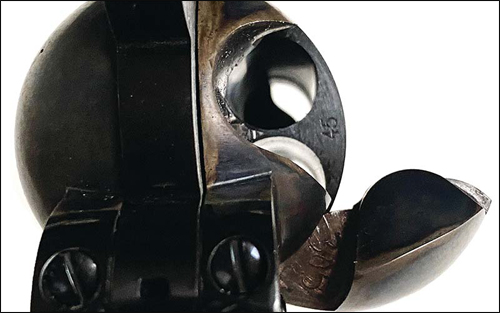
Care must be taken when making ammo for an SAA. These guns are very minimalist and, at least in .45 caliber, have very thin chamber walls. How thin? That may surprise you. The wall thickness at the bolt catch is sometimes as thin as .09 inches!
The Modern Model P
While I have lots of experience with older Colts, I wanted to make sure my assertions were correct for the ones made today. There’s a good deal of frowning from Colt collectors when it comes to anything “Gen 3” or beyond, but I don’t think its warranted.
Colt sent me two brand-new SAAs, one a 4¾-inch and the other a 5.5-inch. Both are chambered in .45 Colt. I decided not to slug the guns and instead opted for using my accuracy loads that Keith recommended in his old works. Some of the advice I take loading this ammo is almost a century old, and it works well even now. Sure enough, I took the new Colts out with my trusted handloads and both printed 2 inches high at 25 meters, the 5.5-inch grouping slightly better at 2 inches.
What separates the Colt SAA revolvers from the replica competition is more what the Colts don’t have. These guns are raw from the factory, no modifications or the like. The trigger pull is crisp, but surprisingly heavy. Cocking the hammer isn’t a chore, however it’s much stiffer than many of the tuned replicas.
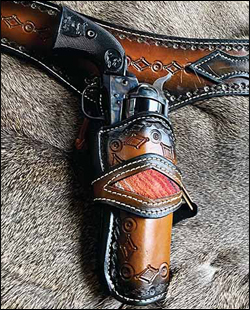
If you’re going to carry a Colt, you need to do it in style. Mernickle Hollywood rigs like this are the best available and will have you practicing your draw in style. A good rig like this makes it so that carrying two guns and ammo feels like nothing; I’ve never worn a more comfortable holster in my life.
An old mentor of mine once told me that, when I got my first Colt, that I needed to leave it alone. In his words, “The only ‘tune’ should be four clicks spelling out C-O-L-T.” I see no reason to modify my new Colts anyway; they’re impressively accurate.
If you go this route with getting a new Colt, you won’t be disappointed. The thing is you need to go out and shoot it. The benefit of Colt guns, especially the revolvers, is that the little pony stamped on the side essentially guarantees your value will never depreciate. People pay good money for Colt guns. Even after shooting them, they’re still valuable. I hear guys get a Colt as a cherry on top of their collection and that the replicas are their “shooters.” I disagree with this. Buy silver and gold if you’re just going to leave in the safe.
Notes On Great Single Action Army Clones
There are some absolutely extraordinary guns out there that rival the Colt, many of which can share parts with it.
The general bulk of SAA production today occurs in Italy. I’ll wager there have been more Italian copies made than Colt originally produced, and most of these are fine guns. The best-quality Single Action Army clones are by Taylor’s & Co. I’ve found over testing and time that the Taylor’s guns are made to an impeccable standard, and their tuning service is second to none. Some of their guns climb in price as you go up in features, but they’re still a savings compared to a Colt.
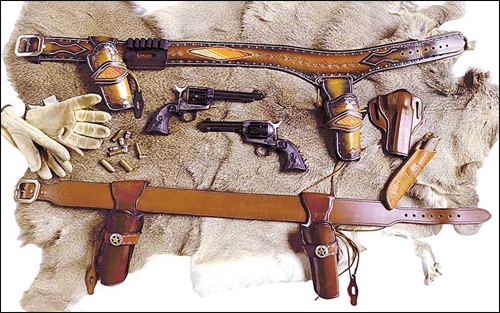
In complete honesty, the only thing I’ve seen on Taylor’s guns I don’t like has been point of impact. All Taylor’s guns I’ve shot shoot straight for windage and average 3 to 4 inches at 25 meters out of the box with factory loads. I love that. However, most shoot low. You can file the sight blade, but you need to be absolutely sure on the load you settle on first before you make that change. Overall, for the cost, I’d strongly recommend Taylor’s if you want to modify your gun or shoot in specific disciplines that favor high-speed features.
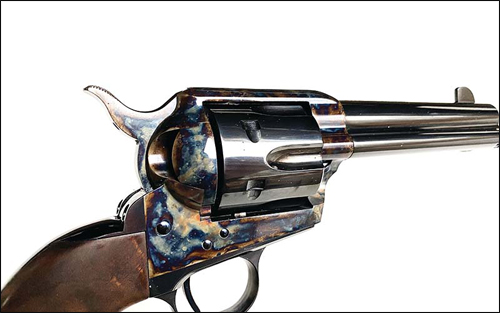
The Standard Manufacturing gun is beautiful, an excellent example of modern craftsmanship. It is, however, not going to appreciate in value like a genuine Colt despite having a higher retail MSRP. A silver lining is that you’ll have no trouble ordering this fine piece; they’re produced regularly.
Another brand I really like is Standard Manufacturing. They made a very beautiful SAA copy that boasts the finest in modern materials and machining. I’m very impressed with the attention to detail and parts fit. It’s slightly different in a couple places as compared to a Colt, especially in the hammer and firing pin geometry. The action isn’t advertised as “tuned,” but it’s far more akin to a custom competition action than a direct replica. You have to listen for the four clicks, but they’re there.
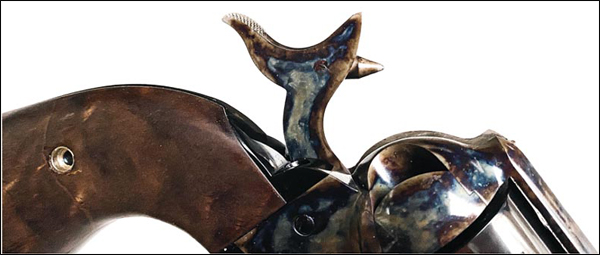
Note the difference in firing pin geometry on the Standard Manufacturing as compared to a Colt. It’s little things like this to be aware of when ordering replacement parts or seeking to make upgrades.
This gun shoots point of aim at 25 meters and is able to print 3-inch groups at that distance easily. Overall, it’s a wonderful, well-made gun that should last a lifetime. It is, of interest, more expensive than a Colt at MSRP for the base mode.
Lastly, I need to talk about the Ruger New Vaquero. This isn’t a Colt Single Action Army clone in any way, except in cosmetics. It is, however, a modern gun in internal design and allows for some added safety features and reduced overall cost. Most guns of this model shoot high as far as I’ve seen, and I don’t like that very much for close distance. I really do love the New Vaquero at 100 yards on plates; it’s almost like Ruger zeros them for a 250-grain bullet at that range.
Quick Links:
Colt Single Action Army Revolvers - 1st Gen - for sale
Colt Single Action Army Revolvers - 2nd Gen - for sale
Colt Single Action Army Revolvers - 3rd Gen - for sale
Check out the huge selection of Revolvers for sale at GunsInternational.com.
Article courtesy of Gun Digest.
The Colt Single Action Army is arguably the most culturally significant firearm in the American story. The gun was, surprisingly, not made in what we could call significant numbers. It’s estimated that Colt’s production of the gun stands today at about a half-million (for reference, Glock has passed 20 million), certainly not a number that should allow it such deep meaning in the great American story considering just how many competitions it had in its time.
Even today, it has competition in the form of clones and copies, arguably more of those have been made than by the Colt company. Since real Colts are often not shot or are considered collector’s items, it’s prudent to examine two new guns and see how they stack up to the competition—and older SAAs from Colt itself.

Does A Colt Shoot Better Than The Rest?
I’ll cut right to the chase when it comes to my personal experience with the SAA. I’ve shot no small number of Single Action Army clones and replicas. The bulk are very fine guns in their own right, some are exceptional shooters and others are exceptional just lying there not being fired. I’ve yet to find a single replica out there that, in terms of materials and accuracy, is the equal of a real Colt SAA.
In my direct experience—thousands of rounds and ranges exceeding 200 yards—have shown me that Colt SAAs are, on average, substantially more accurate than any replica. My average accuracy loads for the .45 Colt have changed a bit over the years, but I’ve recently been using Rim Rock Bullets for my cast loads. These bullets are exceptionally accurate, and I’ve taken a shine to the 255-grain SWC sized at .452 inch. This gets me just shy of 900 fps in a 5.5-inch Colt. My lifetime bench accuracy with Colts is about 2.5 inches at 25 meters, replicas are 4 to 5 inches across the board in group shooting. I never expect a replica to group well on paper as a result or shoot to point of aim, which is a large issue.

The Standard Manufacturing Single Action Revolver (top) versus the Colt. Both of these are 4¾-inch barrels in .45 Colt. They’re externally similar, but vary enough that they can’t be considered a 1:1 copy.
I load my ammo with seating and crimping as two separate operations—some people just use the seating die to crimp. When loading revolver rounds, I like the Lee Factory Crimp Die to manually set the case mouth into the crimp grooves on my bullets. Some people will strongly disagree with me on this, but in my time with cast bullets, I’ve found this uniforms the cartridge far better, and I’ve seen groups tighten.
Many people out there will slug their barrels to determine the best bullet diameter (I know some of my guns shoot much better with .454-inch bullets than they do .452 inch), but there’s a certain economy of scale where I prefer all my guns to shoot well with one or two loads than to have each gun shoot a bit better with a specific load. Again, this is personal preference and I’ve had some that’ll group tighter than a modern match pistol, but I’ll take a 2.5-inch average if I only have to keep one bullet in stock and plan accordingly.

Rim Rock Bullets makes a wide variety of bullets suitable for single actions. This is the author’s new favorite, the 255-grain SWC. It isn’t a true Keith bullet, but it’s just as accurate and great for crossover use for range and field.
Point Of Aim Vs. Point Of Impact
This is the most important issue I’ve seen in my time with these guns. The SAA has no adjustable sights. Adjusting your point of impact is no easy feat, and it’s really best left to a gunsmith because you’re going to have to remove metal on the sight for elevation, or have a smith adjust your barrel in a vice to manually turn it to move windage.

Virtually all Colts I’ve shot shoot point of aim at 25 meters, and if they don’t, they are damn close. Most replicas aren’t so lucky. The only one I’ve had shoot point of aim at this distance was the Standard Manufacturing Single Action Revolver, though it wasn’t as accurate on paper by a noticeable margin. I’ve had three replicas from one manufacturer shoot to three different zip codes with the same ammo. With my Colts, I’ve been able to easily tailor loads to shoot to point of aim. Sometimes I have to sacrifice bullet weight or adjust speed, but I’ve never had a Colt that I’ve failed to reliably hit an IDPA silhouette with at 300 yards.

Colt firing pins are slightly tapered and have a square face. You’ll see a great deal of variance in the hammers on import guns; many have a small safety lever and some even have Ruger-style transfer bars.
I read Elmer Keith as a kid. I thought it was normal to try to hit plates at long range with a revolver after I spent my time reading Sixguns and Sixgun Cartridges and Loads. It’s the definition of fun: waiting for that steel to ring after what seems like an hour of flight time.
The thing that disappoints me on the replicas is that many are what I’d call “cosmetic clones,” in that the functional elements of accuracy are all over the map—or ignored entirely. Sight blade height is a main culprit, as are varied dimensions in barrel alignment and cylinder gap. If you want to be an SAA shooter, whether originals or clones, you need to be a hand-loader. There’s just no way around it; you need the ability to tailor your ammo and even bullet diameters.

Care must be taken when making ammo for an SAA. These guns are very minimalist and, at least in .45 caliber, have very thin chamber walls. How thin? That may surprise you. The wall thickness at the bolt catch is sometimes as thin as .09 inches!
The Modern Model P
While I have lots of experience with older Colts, I wanted to make sure my assertions were correct for the ones made today. There’s a good deal of frowning from Colt collectors when it comes to anything “Gen 3” or beyond, but I don’t think its warranted.
Colt sent me two brand-new SAAs, one a 4¾-inch and the other a 5.5-inch. Both are chambered in .45 Colt. I decided not to slug the guns and instead opted for using my accuracy loads that Keith recommended in his old works. Some of the advice I take loading this ammo is almost a century old, and it works well even now. Sure enough, I took the new Colts out with my trusted handloads and both printed 2 inches high at 25 meters, the 5.5-inch grouping slightly better at 2 inches.
What separates the Colt SAA revolvers from the replica competition is more what the Colts don’t have. These guns are raw from the factory, no modifications or the like. The trigger pull is crisp, but surprisingly heavy. Cocking the hammer isn’t a chore, however it’s much stiffer than many of the tuned replicas.

If you’re going to carry a Colt, you need to do it in style. Mernickle Hollywood rigs like this are the best available and will have you practicing your draw in style. A good rig like this makes it so that carrying two guns and ammo feels like nothing; I’ve never worn a more comfortable holster in my life.
An old mentor of mine once told me that, when I got my first Colt, that I needed to leave it alone. In his words, “The only ‘tune’ should be four clicks spelling out C-O-L-T.” I see no reason to modify my new Colts anyway; they’re impressively accurate.
If you go this route with getting a new Colt, you won’t be disappointed. The thing is you need to go out and shoot it. The benefit of Colt guns, especially the revolvers, is that the little pony stamped on the side essentially guarantees your value will never depreciate. People pay good money for Colt guns. Even after shooting them, they’re still valuable. I hear guys get a Colt as a cherry on top of their collection and that the replicas are their “shooters.” I disagree with this. Buy silver and gold if you’re just going to leave in the safe.
Notes On Great Single Action Army Clones
There are some absolutely extraordinary guns out there that rival the Colt, many of which can share parts with it.
The general bulk of SAA production today occurs in Italy. I’ll wager there have been more Italian copies made than Colt originally produced, and most of these are fine guns. The best-quality Single Action Army clones are by Taylor’s & Co. I’ve found over testing and time that the Taylor’s guns are made to an impeccable standard, and their tuning service is second to none. Some of their guns climb in price as you go up in features, but they’re still a savings compared to a Colt.

In complete honesty, the only thing I’ve seen on Taylor’s guns I don’t like has been point of impact. All Taylor’s guns I’ve shot shoot straight for windage and average 3 to 4 inches at 25 meters out of the box with factory loads. I love that. However, most shoot low. You can file the sight blade, but you need to be absolutely sure on the load you settle on first before you make that change. Overall, for the cost, I’d strongly recommend Taylor’s if you want to modify your gun or shoot in specific disciplines that favor high-speed features.

The Standard Manufacturing gun is beautiful, an excellent example of modern craftsmanship. It is, however, not going to appreciate in value like a genuine Colt despite having a higher retail MSRP. A silver lining is that you’ll have no trouble ordering this fine piece; they’re produced regularly.
Another brand I really like is Standard Manufacturing. They made a very beautiful SAA copy that boasts the finest in modern materials and machining. I’m very impressed with the attention to detail and parts fit. It’s slightly different in a couple places as compared to a Colt, especially in the hammer and firing pin geometry. The action isn’t advertised as “tuned,” but it’s far more akin to a custom competition action than a direct replica. You have to listen for the four clicks, but they’re there.

Note the difference in firing pin geometry on the Standard Manufacturing as compared to a Colt. It’s little things like this to be aware of when ordering replacement parts or seeking to make upgrades.
This gun shoots point of aim at 25 meters and is able to print 3-inch groups at that distance easily. Overall, it’s a wonderful, well-made gun that should last a lifetime. It is, of interest, more expensive than a Colt at MSRP for the base mode.
Lastly, I need to talk about the Ruger New Vaquero. This isn’t a Colt Single Action Army clone in any way, except in cosmetics. It is, however, a modern gun in internal design and allows for some added safety features and reduced overall cost. Most guns of this model shoot high as far as I’ve seen, and I don’t like that very much for close distance. I really do love the New Vaquero at 100 yards on plates; it’s almost like Ruger zeros them for a 250-grain bullet at that range.
Quick Links:
Colt Single Action Army Revolvers - 1st Gen - for sale
Colt Single Action Army Revolvers - 2nd Gen - for sale
Colt Single Action Army Revolvers - 3rd Gen - for sale
Check out the huge selection of Revolvers for sale at GunsInternational.com.
Article courtesy of Gun Digest.







